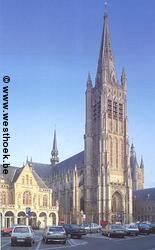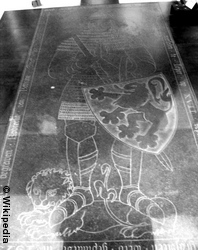
Saint Martin Cathedral at Ieper (Ypres)
Author: Mrs. Myriam Van Lerberghe-Thibaut
History
The impressive Saint Martin Cathedral was built in Ieper (Ypres) between 1221 and 1370. So the construction of this Gothic building, that remained in existence until 1914-1918, lasted 150 years. Before that there was a Romanesque church, probably dating from the tenth or eleventh century.
 The wealth of the city in the thirteenth century provoked general prosperity, even so for religious architecture;
the construction of the Cathedral and the Cloth Hall is supposed to be done in parallel.
The first stone of the church was laid down in 1221: the early Gothic choir. After years of activity and also
interruptions, the west tower was finally built in 1370. That tower collapsed in 1433, was rebuilt immediately and was completed
in 1475.
The wealth of the city in the thirteenth century provoked general prosperity, even so for religious architecture;
the construction of the Cathedral and the Cloth Hall is supposed to be done in parallel.
The first stone of the church was laid down in 1221: the early Gothic choir. After years of activity and also
interruptions, the west tower was finally built in 1370. That tower collapsed in 1433, was rebuilt immediately and was completed
in 1475.
Following the complete destruction during World War I, the church was rebuilt on its XIII c. basement into its current layout.
The new building is a nearly exact replica of the former Gothic building. This is so thanks to architect Jules Coomans, residing in Ieper, who executed some renovation on the building (and the Cloth Hall) just before the outbreak of World War I. He escaped the force of arms and took his schemes with him. So in 1918, after the war, he could commence the reconstruction based on the 1914 plans.
Visit
While visiting the church: pay attention to the choir area with the neo-Gothic choir screen, the organ in the north transept, the beautiful rose window in the south transept.
In the front is located the tombstone of count Robrecht of Béthune of Flanders, the "Lion of Flanders". In the south side chapel stands the miraculous statue of Our Lady of Thuyne.
Around the sanctuary one finds a monumental fence with wrought iron decorations. On it the coat of arms of the 18 bishops of Ieper are attached, as Ieper was a diocese between 1559 and 1801. This is the reason why the Saint Martin church holds the title cathedral.
Robrecht of Béthune
 Discovering the ties in history one can experience how fascinating history can be indeed. Here is an example:
Robrecht (Robert) of Béthune, buried here, was count of Flanders at the time of the Battle of the Golden Spurs in 1302.
Discovering the ties in history one can experience how fascinating history can be indeed. Here is an example:
Robrecht (Robert) of Béthune, buried here, was count of Flanders at the time of the Battle of the Golden Spurs in 1302.
However he did not fight when his army was engaged in the battle, contrary to the story of Hendrik Conscience in his novel "Leeuw van Vlaanderen" ("Lion of Flanders").
Robrecht of Béthune resisted with his father, Gwijde (Guy) of Dampierre, against the plans of the king of France, Philip IV (Philippe le Bel), who was their liege lord and wanted to join Flanders to the crown lands of France. They broke up all feudal links with their liege lord on January 20, 1297. But when resistance proved to be in vain, Robrecht of Béthune surrended together with his father, Gwijde of Dampierre, and his brother Willem (William) of Crèvecoeur and were imprisoned in the Chinon castle by the king of France in May 1300. This way they hoped to avoid the war with France.
They did not succeed. The war came in 1302: the Battle of the Golden Spurs. The father died in captivity and after his death Robrecht was allowed to come back to Flanders, in 1305, well after the Battle of the Golden Spurs.
Our commentators: